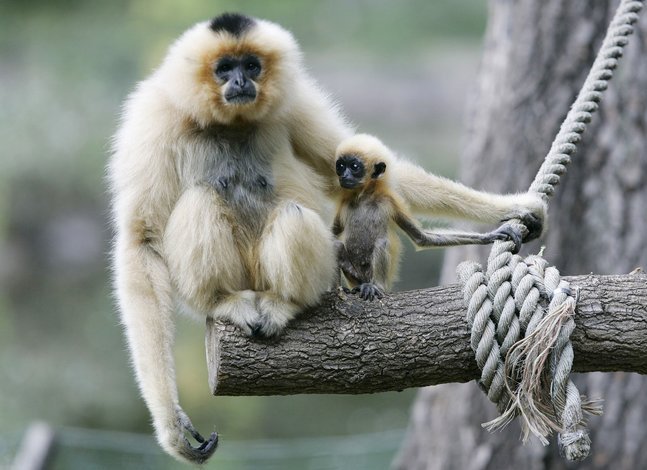Gibbon
Gibbons are apes in the family Hylobatidae (pron.: /?ha?lbe?t?di?/). The family historically contained one genus, but now is split into four genera. Gibbons occur in tropical and subtropical rainforests from northeast India to Indonesia and north to southern China, including the islands of Sumatra, Borneo, and Java. Also called the lesser apes, gibbons differ from great apes (chimpanzees, gorillas, orangutans and humans) in being smaller, exhibiting low sexual dimorphism, in not making nests, and in certain anatomical details in which they superficially more closely resemble monkeys than great apes do. But like all apes, gibbons evolved to become tailless. Gibbons also display pair-bonding, unlike most of the great apes. Gibbons are masters of their primary mode of locomotion, brachiation, swinging from branch to branch for distances of up to 15 m (50 ft), at speeds as high as 55 km/h (34 mph). They can also make leaps of up to 8 m (26 ft), and walk bipedally with their arms raised for balance. They are the fastest and most agile of all tree-dwelling, non-flying mammals. Depending on species and gender, gibbons' fur coloration varies from dark to light brown shades, and anywhere between black and white. It is rare to see a completely white gibbon. Gibbon species include the siamang, the white-handed or lar gibbon, and the hoolock gibbons The dating of the evolution of these genera has been difficult. The best current estimates place Nomascus diverging from the other genera about 8 million years ago (Mya), and Symphalangus and Hylobates diverging at 7 Mya. At the species level, Hylobates pileatus diverged from H. lar and H. agilis at 3.9 Mya, and H. lar and H. agilis separated at 3.3 Mya. The extinct Bunopithecus sericus is a gibbon or gibbon-like ape which, until recently, was thought to be closely r

lated to the hoolock gibbons. Many gibbons are hard to identify based on fur coloration, so are identified either by song or genetics. These morphological ambiguities have led to hybrids in zoos. Zoos often receive gibbons of unknown origin and therefore rely on morphological variation or labels that are impossible to verify to assign species and subspecies names, so it is common for separate species of gibbons to be misidentified and housed together. Interspecific hybrids, hybrids within a genus, also occur in wild gibbons where the ranges overlap. [edit]Physical description One unique aspect of gibbon anatomy is that the wrist is composed of a ball and socket joint, allowing for biaxial movement. This greatly reduces the amount of energy needed in the upper arm and torso, while also reducing stress on the shoulder joint. Sometimes when a gibbon is swinging, its wrist will naturally dislocate until the gibbon finishes its swing.[citation needed] Gibbons also have long hands and feet, with a deep cleft between the first and second digits of their hands. Their fur is usually black, gray, or brownish, often with white markings on hands, feet, and face. The male gibbon will sometimes end up with some dark patches in the white to show it is a suitable choice for mating.[vague] Some species have an enlarged throat sac, which inflates and serves as a resonating chamber when the animals call. This structure is enormous in a few species, equaling the size of the animal's head. Gibbon skulls and teeth resemble those of the great apes, and their noses are similar to those of all catarrhine primates. The dental formula is The siamang, which is the largest of the 17 species, is distinguished by having two fingers on each foot stuck together, hence the generic and species names Symphalangus and syndactylus